Socio-Spatial Changes in Danwei Neighbourhoods: A Case Study of the AMS Danwei Compound in Hefei, China
Abstract
:1. Introduction
2. Socio-Spatial Changes in Urban Neighbourhoods: A Framework
3. Materials and Methods
3.1. Overview of Hefei City and the AMS Danwei Compound
3.2. Methodology
3.2.1. Data Collection
3.2.2. Data Processing and Analysis
4. Results
4.1. Physical Space Changes
4.1.1. Boundary and Density
4.1.2. Public Space
4.1.3. Spatial Syntax Analysis
4.2. Building Features
4.3. The Use of Public Spaces and Public Facilities
4.4. Compound Management
5. Discussion
6. Urban Planning Implications and Conclusions
Author Contributions
Funding
Data Availability Statement
Conflicts of Interest
Abbreviations
| PRC | People’s Republic of China |
| AMS | Anhui Academy of Medical Science |
References
- Skocpol, T. States and Social Revolutions: A Comparative Analysis of France, Russia and China/Theda Skocpol; Cambridge University Press: Cambridge, UK, 1979. [Google Scholar]
- Bray, D. Social Space and Governance in Urban China: The Danwei System from Origins to Reform/David Bray; Stanford University Press: Stanford, CA, USA, 2005. [Google Scholar]
- Wu, H. The Danwei Tradition in Chinese Organizational Identification and Its Modern Changes. J. Soc. Sci. Hunan Norm. Univ. 2016, 45, 49–56. (In Chinese) [Google Scholar]
- Fang, C.-L. The urbanization and urban development in China after the reform and opening-up. Econ. Geogr. 2009, 29, 19–25. [Google Scholar]
- Wen, T. The Eight Crises: China’s Real Experience 1949–2009; The Oriental Press: Beijing, China, 2013. (In Chinese) [Google Scholar]
- Liu, J. Danwei China; Tianjin People’s Publishing House: Tianjing, China, 2000. (In Chinese) [Google Scholar]
- Tian, Y. Changes in the “Danwei Community” and Urban Community Renewal, 1st ed.; National Achievements Library of Philosophy and Social Sciences, Central Compilation & Translation Press: Beijing, China, 2014. (In Chinese) [Google Scholar]
- Li, J.; Dai, S. 60 years of urban land-use system reform in China: A review and outlook. Rev. Econ. Res. 2009, 63, 2–10. [Google Scholar]
- Zhang, C.; Chai, Y. The Residential Residual in Danwei Community and Its Impact Factor. Urban Plan. Int. 2009, 24, 15–19. (In Chinese) [Google Scholar]
- Tanigawa, S. The origin of the “Danwei” system in Anti-Japanese Base Area. Asian Stud. 1999, 44, 67–106. (In Japanese) [Google Scholar] [CrossRef]
- Bian, M.L. The Making of the State Enterprise System in Modern China: The Dynamics of Institutional Change; Harvard University Press: Cambridge, MA, USA; London, UK, 2005. [Google Scholar]
- Zhou, Y.; Yang, X. China Danwei System; China Economic Publishing House: Beijing, China, 2002. (In Chinese) [Google Scholar]
- Peiling, Z. A socio-economic-cultural exploration on open space form and everyday activities in Danwei: A case study of Jingmian compound, Beijing. Urban Des. Int. 2014, 19, 22–37. [Google Scholar] [CrossRef]
- Zhang, C.; Chai, Y.; Zhou, Q. The Spatiality and Spatial Changes of Danwei Compound in Chinese Cities: Case Study of Beijing No.2 Textile Factory. Urban Plan. Int. 2009, 24, 20–27. (In Chinese) [Google Scholar]
- Ye, N.; Kita, M.; Matsubara, S.; Okyere, S.A.; Shimoda, M. A Study of the Spatial Distribution of Danwei Compounds in the Old Town of Hefei, China. Urban Sci. 2021, 5, 7. [Google Scholar] [CrossRef]
- Ye, N.; Wang, B.; Kita, M.; Xie, M.; Cai, W. Urban Commerce Distribution Analysis Based on Street View and Deep Learning. IEEE Access 2019, 7, 162841–162849. [Google Scholar] [CrossRef]
- Lee, T. Urban Neighbourhood as a Socio-Spatial Schema. Hum. Relat. 1968, 21, 241–267. [Google Scholar] [CrossRef]
- Wang, Y.; Liu, K. Evolution of Urban Socio-Spatial Structure in Modern Times in Xi’an, China. Sustainability 2017, 9, 1935. [Google Scholar] [CrossRef] [Green Version]
- He, S. Evolving enclave urbanism in China and its socio-spatial implications: The case of Guangzhou. Soc. Cult. Geogr. 2013, 14, 243–275. [Google Scholar] [CrossRef]
- Öymen Gür, S.; Enön, Z. Changing socio—Spatial aspects of neighborhood: Design implications. Ekistics 1990, 57, 138–145. [Google Scholar]
- Sykora, L. Processes of Socio-spatial Differentiation in Post-communist Prague. Hous. Stud. 1999, 14, 679–701. [Google Scholar] [CrossRef] [Green Version]
- Eranıl Demirli, M.; Tuna Ultav, Z.; Demirtaş-Milz, N. A socio-spatial analysis of urban transformation at a neighborhood scale: The case of the relocation of Kadifekale inhabitants to TOKİ Uzundere in İzmir. Cities 2015, 48, 140–159. [Google Scholar] [CrossRef]
- He, S.; Wu, F. Socio-spatial impacts of property-led redevelopment on China’s urban neighbourhoods. Cities 2007, 24, 194–208. [Google Scholar] [CrossRef]
- Li, Z.; Wu, F. Socio-spatial Differentiation and Residential Inequalities in Shanghai: A Case Study of Three Neighbourhoods. Hous. Stud. 2006, 21, 695–717. [Google Scholar] [CrossRef]
- Hefei Planning Bureau. Hefei Urban Planning Record; HuangShan Books: Hefei, China, 2013.
- Hefei City Statistics Bureau. Hefei City 2019 National Economic and Social Development Statistics Bulletin. 2020. Available online: http://tjj.hefei.gov.cn/tjyw/tjgb/14578501.html (accessed on 2 December 2020).
- Hefei Local Gazetteers Compilation Committee. Local Gazetteers of Hefei; Anhui Sheng Di Fang Zhi Cong Shu, Anhui Peoples Publishing House: Hefei, China, 1999. [Google Scholar]
- National Bureau of Statistics. Annual Demographic Data for China. 2019. Available online: https://data.stats.gov.cn/easyquery.htm?cn\\=C01&zb=A0301&sj=2019 (accessed on 14 October 2020).
- Byrne, M.M. Evaluating the findings of qualitative research. AORN J. 2001, 73, 703–706. [Google Scholar] [CrossRef] [Green Version]
- Okumah, M.; Martin-Ortega, J.; Chapman, P.J.; Novo, P.; Cassidy, R.; Lyon, C.; Higgins, A.; Doody, D. The role of experiential learning in the adoption of best land management practices. Land Use Policy 2021, 105, 105397. [Google Scholar] [CrossRef]
- Aptekar, S. Looking Forward, Looking Back: Collective Memory and Neighborhood Identity in Two Urban Parks. Symb. Interact. 2017, 40, 101–121. [Google Scholar] [CrossRef]
- Jeanneret Brith, F.J.; Reyes Andreani, M.J.; Cruz Contreras, M.A.; Castillo Vega, C.M.; Jeanneret Brith, J.E.; Pavez Pérez, J.F.; Badilla Rajevic, M. Joint action as a practice of memory transmission in a poor urban neighborhood of Santiago, Chile. J. Community Psychol. 2021, 49, 58–76. [Google Scholar] [CrossRef]
- Thomas, J.M. Neighborhood Planning: Uses of Oral History. J. Plan. Hist. 2004, 3, 50–70. [Google Scholar] [CrossRef]
- Hallowell, G.; Baran, P. Neighborhood Dynamics and Long–Term Change. Geogr. Anal. 2020. [Google Scholar] [CrossRef]
- Bendjedidi, S.; Bada, Y.; Meziani, R. Urban plaza design process using space syntax analysis. Int. Rev. Spat. Plan. Sustain. Dev. 2019, 7, 125–142. [Google Scholar] [CrossRef] [Green Version]
- Garau, C.; Annunziata, A.; Yamu, C. A walkability assessment tool coupling multi-criteria analysis and space syntax: The case study of Iglesias, Italy. Eur. Plan. Stud. 2020, 1–23. [Google Scholar] [CrossRef]
- Wang, F. Streets and Lanes. disP Plan. Rev. 2017, 53, 45–49. [Google Scholar] [CrossRef] [Green Version]
- Francis, J.; Giles-Corti, B.; Wood, L.; Knuiman, M. Creating sense of community: The role of public space. J. Environ. Psychol. 2012, 32, 401–409. [Google Scholar] [CrossRef]
- Bonaiuto, M.; Fornara, F.; Bonnes, M. Indexes of perceived residential environment quality and neighbourhood attachment in urban environments: A confirmation study on the city of Rome. Landsc. Urban Plan. 2003, 65, 41–52. [Google Scholar] [CrossRef]
- Abu Hatab, A.; Cavinato, M.E.R.; Lindemer, A.; Lagerkvist, C.J. Urban sprawl, food security and agricultural systems in developing countries: A systematic review of the literature. Cities 2019, 94, 129–142. [Google Scholar] [CrossRef]
- Coq-Huelva, D.; Asián-Chaves, R. Urban Sprawl and Sustainable Urban Policies. A Review of the Cases of Lima, Mexico City and Santiago de Chile. Sustainability 2019, 11, 5835. [Google Scholar] [CrossRef] [Green Version]
- Wang, X.; Shi, R.; Zhou, Y. Dynamics of urban sprawl and sustainable development in China. Socio-Econ. Plan. Sci. 2020, 70, 100736. [Google Scholar] [CrossRef]
- Roseland, M. Dimensions of the eco-city. Cities 1997, 14, 197–202. [Google Scholar] [CrossRef]
- Tumlin, J. Sustainable Transportation Planning: Tools for Creating Vibrant, Healthy, and Resilient Communities; John Wiley & Sons: Hoboken, NJ, USA, 2012; Volume 16. [Google Scholar]
- Lu, S.; Huang, Y.; Shi, C.; Yang, X. Exploring the Associations Between Urban Form and Neighborhood Vibrancy: A Case Study of Chengdu, China. ISPRS Int. J. Geo-Inf. 2019, 8, 165. [Google Scholar] [CrossRef] [Green Version]
- Nishimoto, Y. Friendly Authoritarianism and Neighborhood Associations in Rural Japan-A Case from Noto Peninsula. Bull. Fac. Hum. Sci. Kanazawa Univ. 2018, 1–24. [Google Scholar]
- Tian, Y. The Pain of Urban Social Management in China in Transition—An Analytical Perspective on Social Atomisation. Explor. Free Views 2012. (In Chinese) [Google Scholar] [CrossRef]
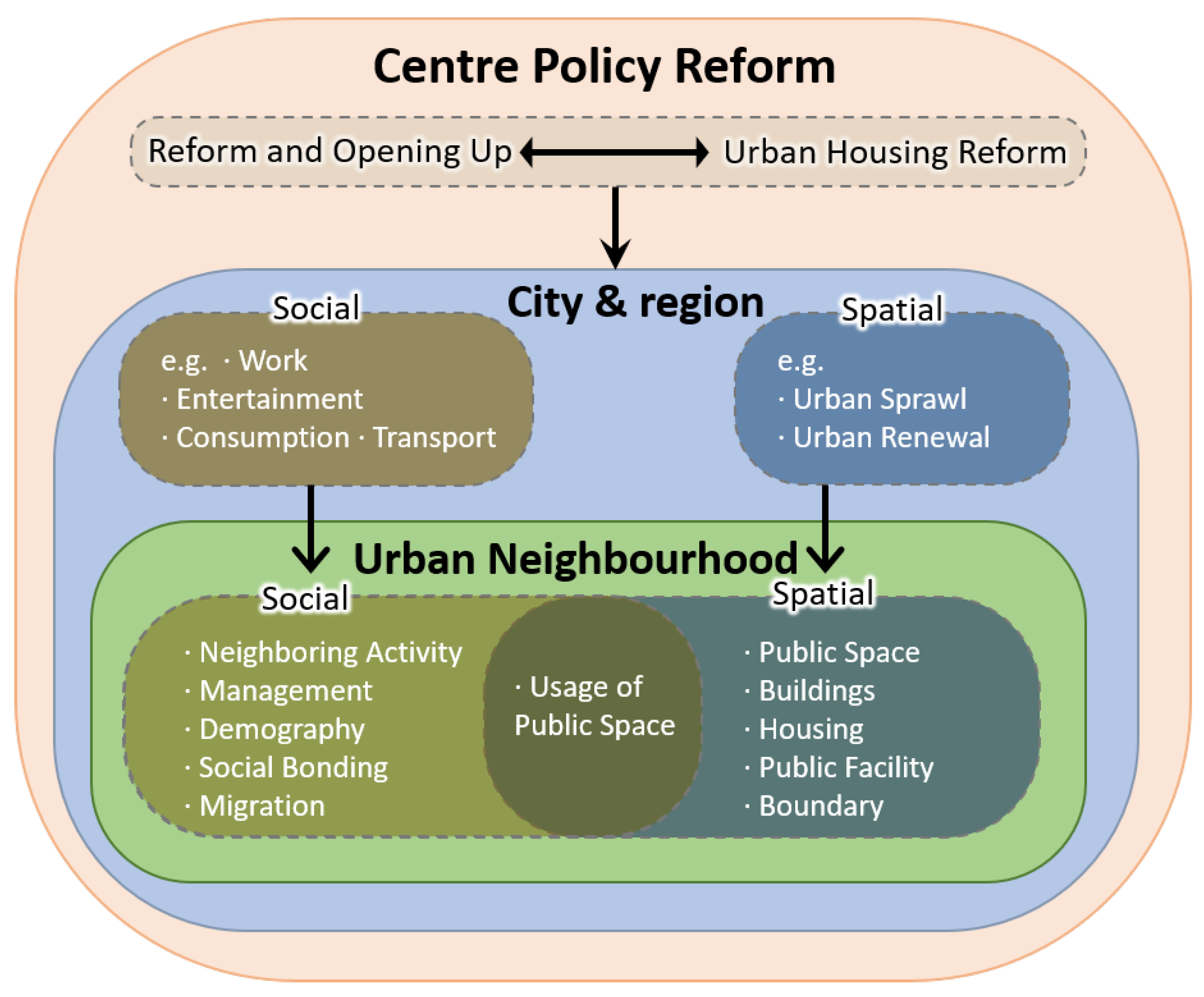
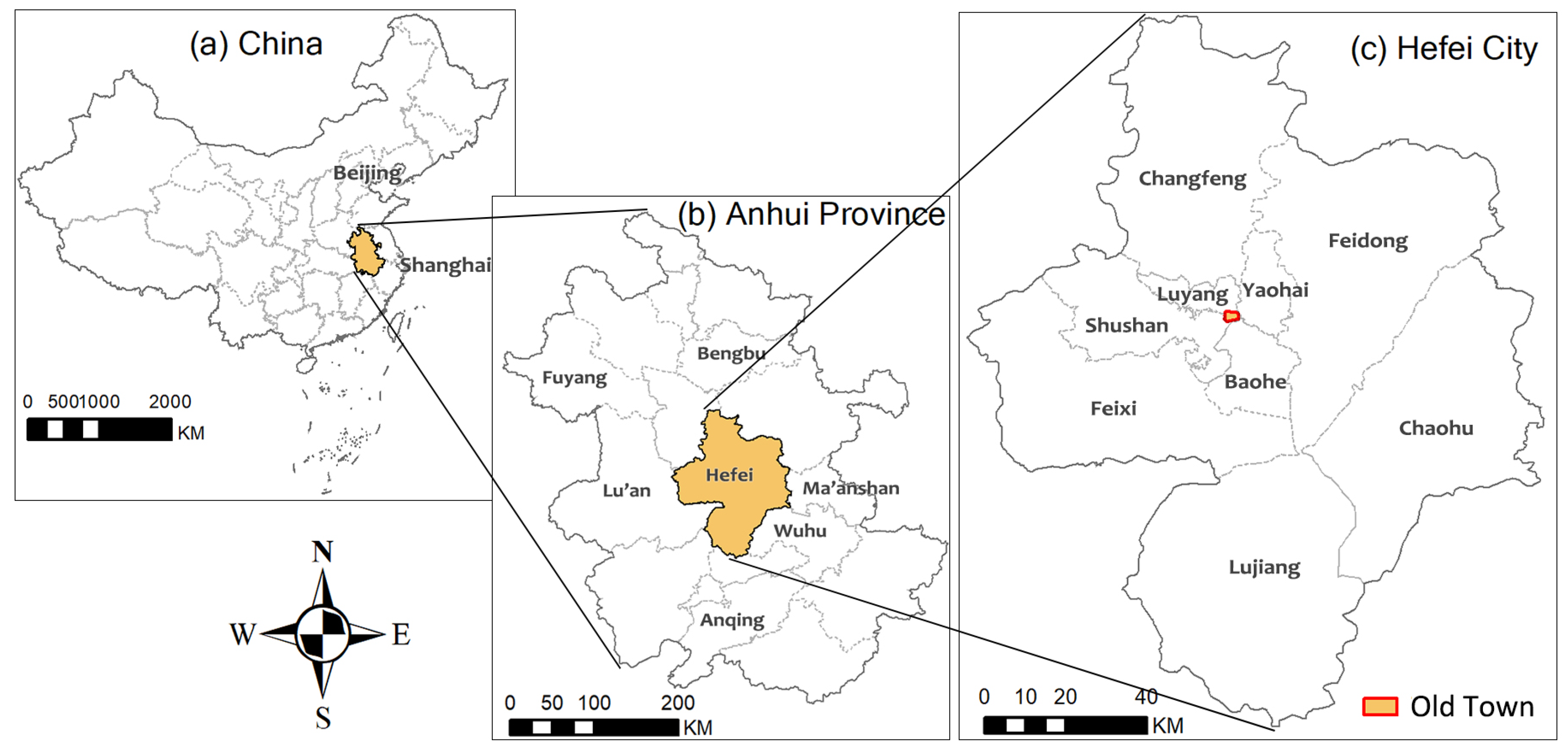


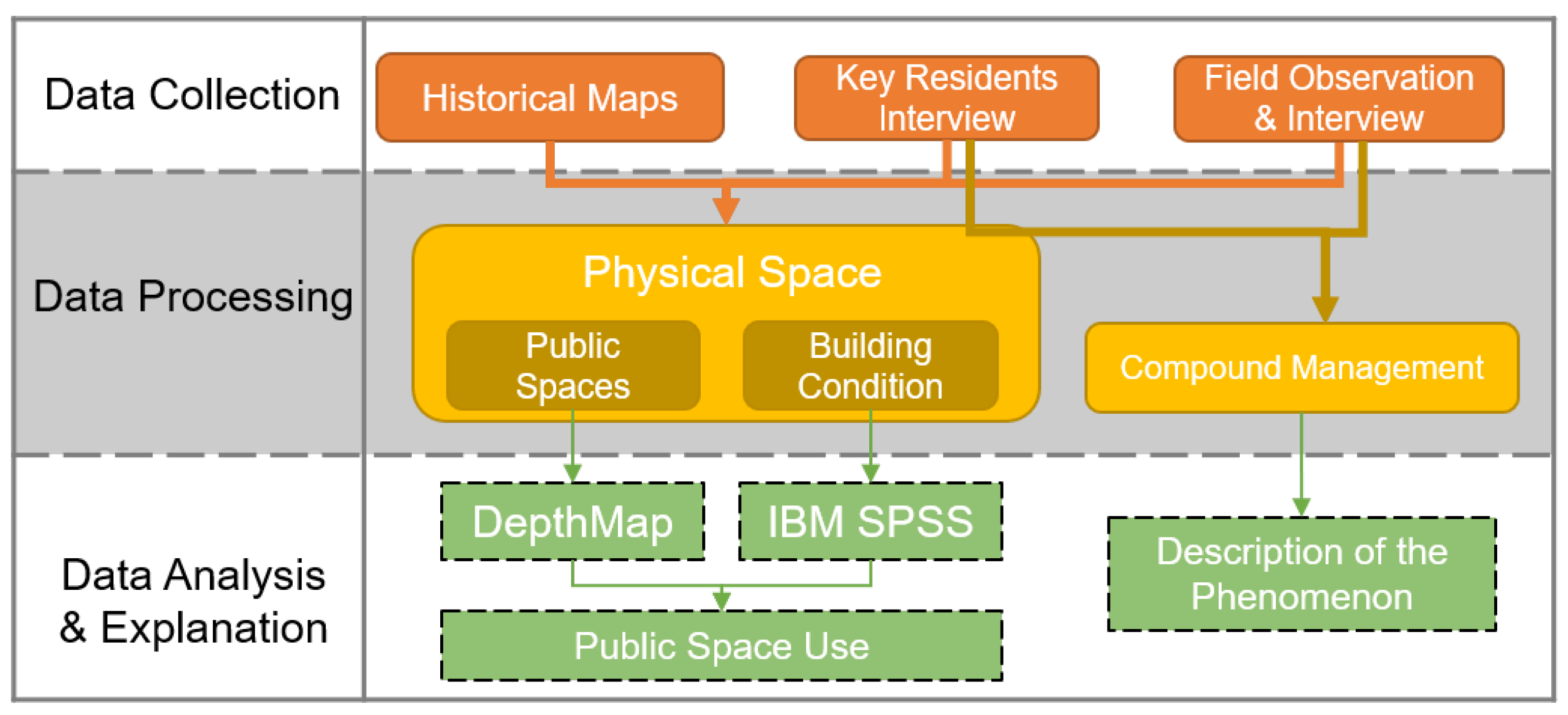



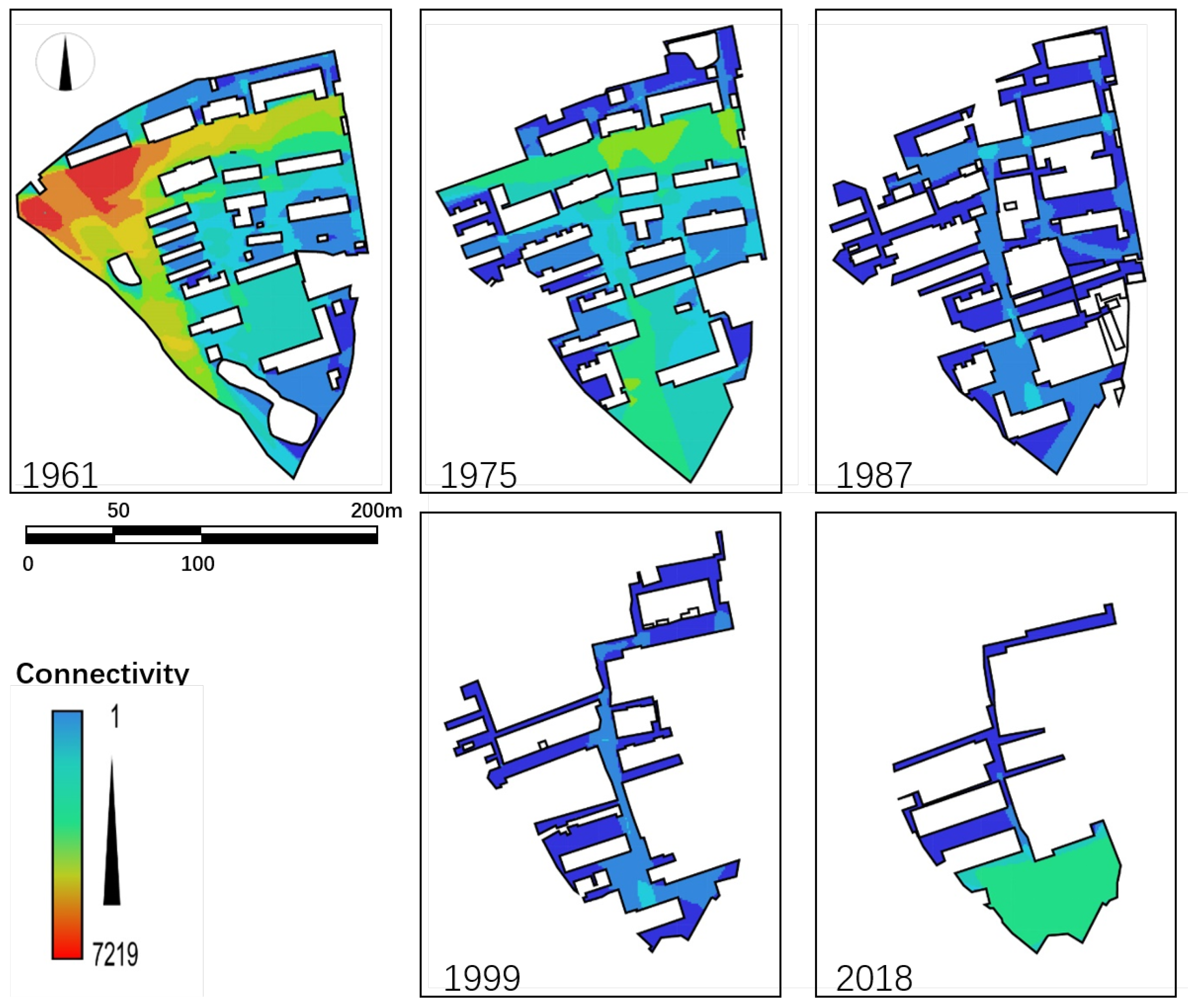
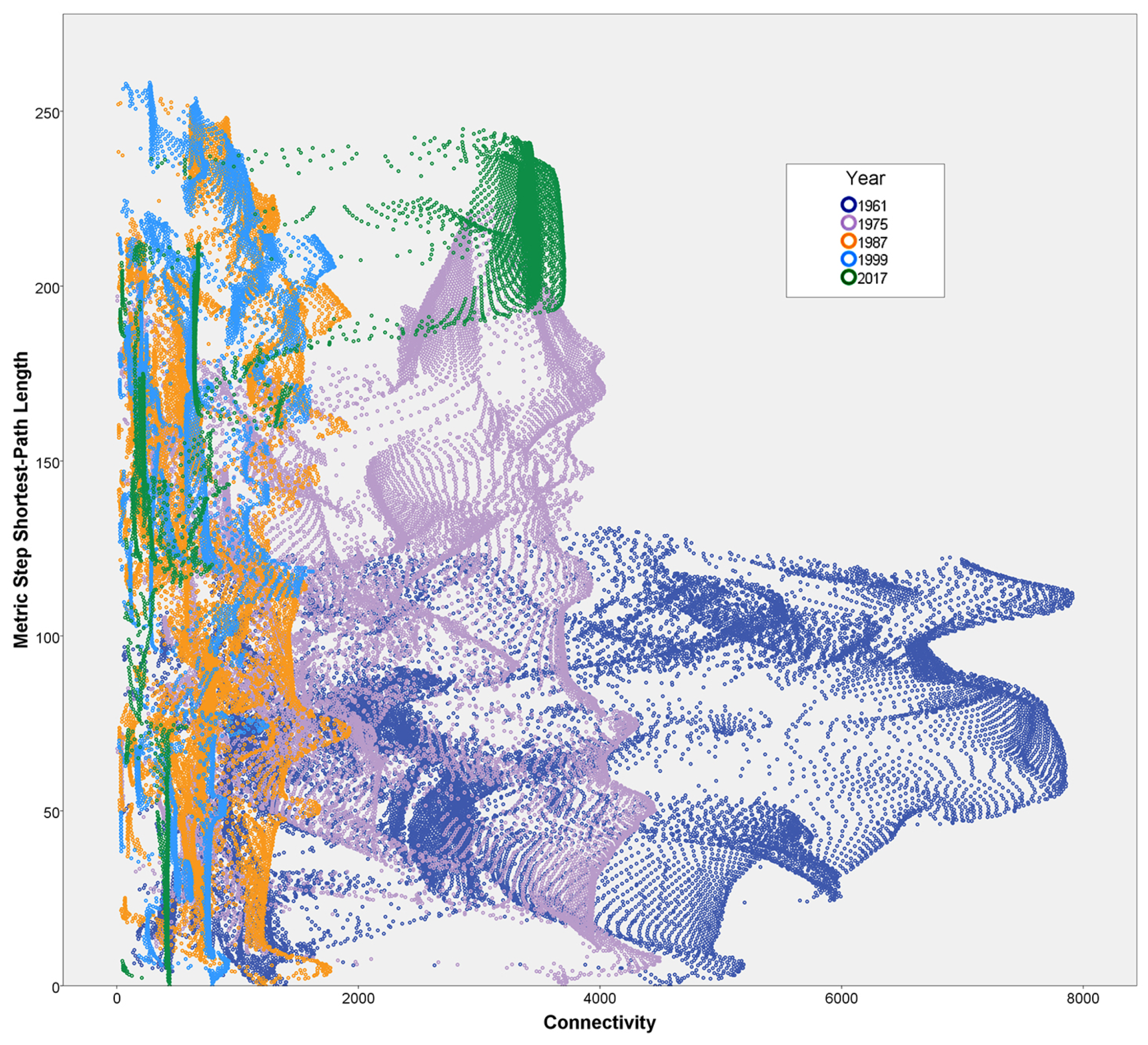
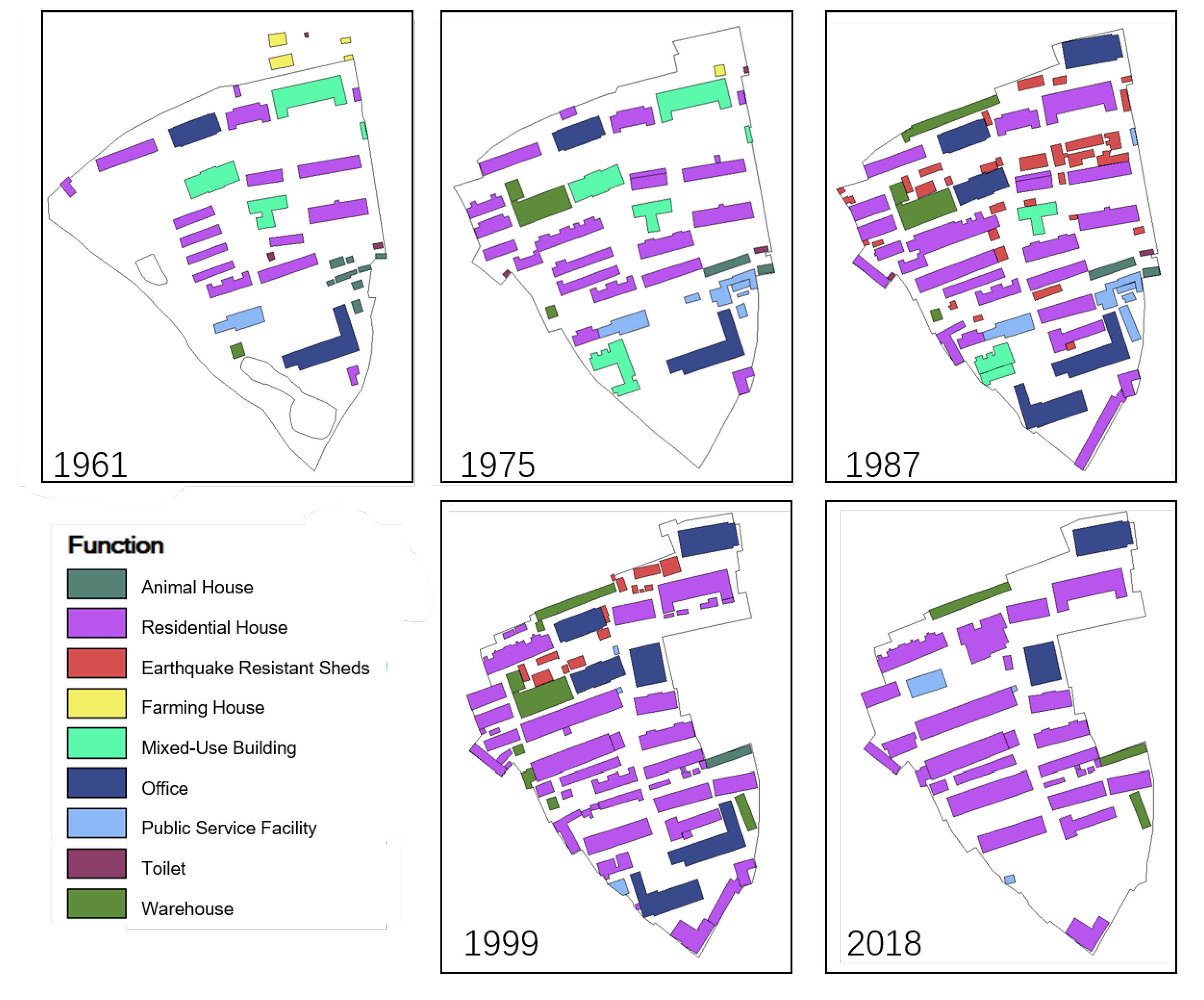

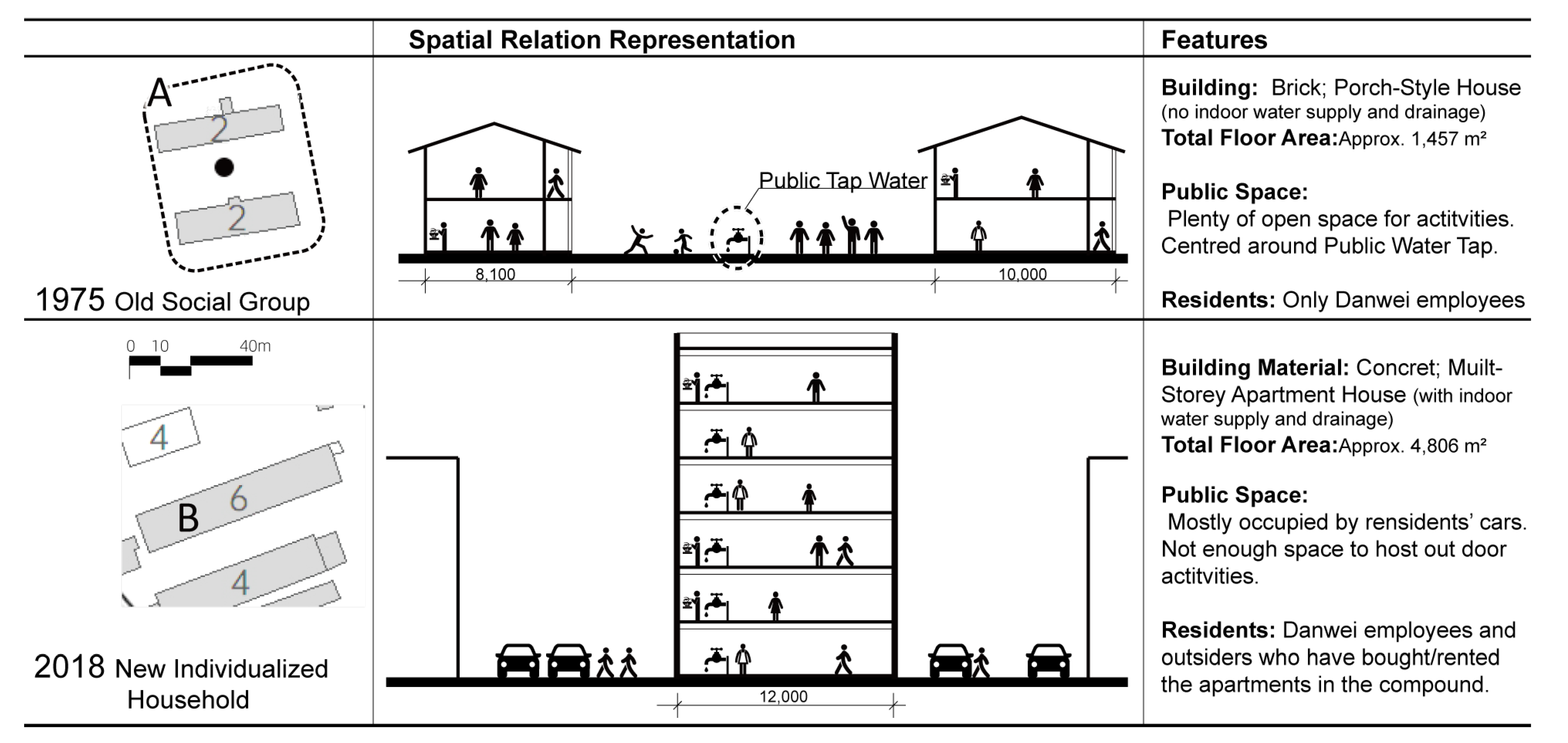

| Author & Year | Location | Backgroud | Elements | Focus | |
|---|---|---|---|---|---|
| Gür, S., & Enön, Z. (1990). | six neighbourhoods in Turkey | Comparison of different communities over the same period | spatial | Layout | Design implications |
| Microclimate | |||||
| Open space | |||||
| Street | |||||
| Building condition | |||||
| socio | Neighboring activities | ||||
| Social and cultural | |||||
| Residents’ attitude | |||||
| Li, Zhigang; Wu, Fulong (2006) | Three neighbourhoods in Shanghai, China | Comparison of different communities over the same period | socio-spatial | Socio-economic status | Residential inequalities |
| Housing type | |||||
| Residential inequalities | |||||
| He, Shenjing; Wu, Fulong (2007) | Two neighbourhoods in Shanghai, China | Comparison of different communities over the same period | spatial | Building style | Impacts of property-led redevelopment |
| Average floor area | |||||
| Housing facilities | |||||
| Change of housing conditions in 10 years | |||||
| socio | Education level | ||||
| Working condition | |||||
| Income | |||||
| Housing tenure | |||||
| Eranıl Demirli, Meltem; Tuna Ultav, Zeynep; Demirtaş-Milz, Neslihan (2015) | The relocation of a neighbourhood in İzmir, Turkey | Comparison of before and after community relocation | spatial | Common spaces | Impacts of neighbourhood relation |
| Housing style | |||||
| Noise | |||||
| Children play space | |||||
| Shops | |||||
| socio | Migration | ||||
| Traditional values | |||||
| Social solidarity | |||||
| Olfactory recognition | |||||
| Social bonding | |||||
| Gu, Chaolin; Shen, Jianafa (2003) | Beijing, China | Macro Urban Community Study | socio-spatial | Urban function | Transformation of urban socio-spatial structure in Economic system transition |
| Capital | |||||
| Migration | |||||
| Urban renewal | |||||
| Urban sprawl | |||||
| Wang, Yanjun; Liu, Kewei. (2017) | Xi’an, China | Macro Urban Community Study | socio-spatial | Population | Urban development and evolutionary mechanisms |
| Household | |||||
| Industry | |||||
| Occupation | |||||
| Housing | |||||
| Sykora, Ludek. (1999) | Prague, Czech Republic | Macro Urban Community Study | socio-spatial | Income | Post-communist transition and Socio- spatial Differentiation |
| Housing system | |||||
| Social mobility & migration | |||||
| He, Shenjing (2013) | Guangzhou, China | Macro Urban Community Study | socio-spatial | Housing | Enclave Urbanism |
| Socio-economic status | |||||
| Demography | |||||
| Management | |||||
| Socio-Spatial Elements | Before the Reforms | After the Reforms |
|---|---|---|
| Public Spaces | KP, MA | MA, FO |
| Building Features | KP, MA | MA, FO |
| Usage of Public Spaces | KP, MA | MA, FO |
| Compound Management | KP | FO |
| 1961 | 1975 | 1987 | 1999 | 2018 | |
|---|---|---|---|---|---|
| Building Density | 20% | 27% | 42% | 48% | 48% |
| Plot Ratio | 32% | 47% | 77% | 149% | 151% |
| 1961 | 1975 | 1987 | 1999 | 2018 | |
|---|---|---|---|---|---|
| Public Space Area (m) | 29,740 | 25,870 | 17,060 | 9690 | 8200 |
| Public Space Ratio | 75% | 65% | 42% | 28% | 24% |
| 1961 | 1975 | 1987 | 1999 | 2018 | |
|---|---|---|---|---|---|
| Total Building Area (m) | 12,699 | 18,543 | 31,032 | 51,386 | 51,862 |
| In Which: Retention Area (m) | 11,001 | 17,736 | 23,054 | 39,287 | |
| In Which: New Build Area (m) | 6180 | 13,973 | 26,626 | 12,574 | |
| Average New Building Area (m) | 326 | 247 | 318 | 634 | 2096 |
| New Build/Total Area Ratio | 33% | 45% | 52% | 24% | |
| Total Quantity | 39 | 41 | 75 | 78 | 36 |
| In Which: Retention Quantity | 16 | 31 | 36 | 30 | |
| In Which: New Build Quantity | 25 | 44 | 42 | 6 |
| Building Area by Function (m|%) | 1961 | 1975 | 1987 | 1999 | 2018 | |||||
|---|---|---|---|---|---|---|---|---|---|---|
| Office | 2388 | 19% | 3250 | 18% | 10,086 | 32% | 14,118 | 27% | 6940 | 13% |
| Residential House | 5643 | 44% | 8565 | 46% | 15,323 | 49% | 34,605 | 67% | 42,782 | 82% |
| Mixed-Use Building | 3598 | 28% | 4670 | 25% | 997 | 3% | 0 | 0% | 0 | 0% |
| Warehouse | 79 | 1% | 841 | 5% | 1308 | 4% | 1558 | 3% | 752 | 1% |
| Public Service Facility | 346 | 3% | 848 | 5% | 961 | 3% | 129 | 0% | 1387 | 3% |
| Farming House | 277 | 2% | 51 | 0% | 0 | 0% | 0 | 0% | 0 | 0% |
| Toilet | 57 | 0% | 47 | 0% | 51 | 0% | 0 | 0% | 0 | 0% |
| Animal House | 311 | 2% | 270 | 1% | 270 | 1% | 203 | 0% | 0 | 0% |
| Earthquake Resilient Shelter | 0 | 0 | 0 | 0 | 2051 | 7% | 789 | 2% | 0 | 0 |
| Maintenance Activities | Actors | Period | |
|---|---|---|---|
| Before the Reforms | After the Reforms | ||
| Garbage Collection | Initiators | Government | Government |
| Funding | Danwei | Government | |
| Participants | Employee | Employee | |
| Compound Cleaning | Initiators | Danwei | Resident |
| Funding | Danwei | Resident | |
| Participants | Employee, Resident | Resident | |
| Facility/Equipment Maintenance | Initiators | Danwei | Resident |
| Funding | Danwei | Government | |
| Participants | Employee | Employee | |
| Human Excreta Disposal | Initiators | Danwei | - |
| Funding | - | - | |
| Participants | Outsider | - | |
Publisher’s Note: MDPI stays neutral with regard to jurisdictional claims in published maps and institutional affiliations. |
© 2021 by the authors. Licensee MDPI, Basel, Switzerland. This article is an open access article distributed under the terms and conditions of the Creative Commons Attribution (CC BY) license (https://creativecommons.org/licenses/by/4.0/).
Share and Cite
Ye, N.; Kita, M.; Matsubara, S.; Okyere, S.A.; Shimoda, M. Socio-Spatial Changes in Danwei Neighbourhoods: A Case Study of the AMS Danwei Compound in Hefei, China. Urban Sci. 2021, 5, 35. https://0-doi-org.brum.beds.ac.uk/10.3390/urbansci5020035
Ye N, Kita M, Matsubara S, Okyere SA, Shimoda M. Socio-Spatial Changes in Danwei Neighbourhoods: A Case Study of the AMS Danwei Compound in Hefei, China. Urban Science. 2021; 5(2):35. https://0-doi-org.brum.beds.ac.uk/10.3390/urbansci5020035
Chicago/Turabian StyleYe, Nanqi, Michihiro Kita, Shigeki Matsubara, Seth Asare Okyere, and Motoki Shimoda. 2021. "Socio-Spatial Changes in Danwei Neighbourhoods: A Case Study of the AMS Danwei Compound in Hefei, China" Urban Science 5, no. 2: 35. https://0-doi-org.brum.beds.ac.uk/10.3390/urbansci5020035






